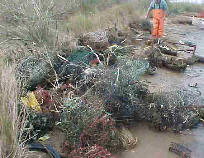|
Tracking Down Ghost Nets
June 20, 2002
By Michelle Esteban
SAN JUAN ISLANDS - Ghost nets are killing fish and threatening the ecosystem. Ghost nets are lost fishing nets and there are literally tons of them in the waters around Washington.
The first was pulled Thursday north of Roche Harbor on San Juan Island.
It's easy to get distracted on the waters of the Pacific Northwest. From the San Juan Island's scenery to the water dance compliments of killer whales - both J Pod & K Pod were out Thursday.
But it's what you can't see -- what's below the water's surface that has brought a team of divers to the rescue.
They're hunting old forgotten fishing nets -- some nets are a mile long and hundreds of feet wide.
"These things are very deadly," said Steve Jennison, Orca District Manager with the Washington State Department of Natural Resources. "They entangle sea creatures then they become food for other fish who get entangled and they become a perpetual killing machine."
Fishing nets never stop fishing. A diver had to come up for air and help. He got tangled in a knotted ball or fishing line and debris while trying to detangle the net.
"Sometimes you get monofilament and sometimes steel cable," said the diver.
Sometimes they get divers. Jennison says two divers in California were killed when they were caught in a ghost net.
In most cases the nets entangle rock fish, ling cod and Puget Sound Box Crabs.
Removing the derelict fishing nets is a slow job. Divers go 100 feet down to find the net, then they have to free it from rock and reef.
The net goes deeper, but the divers can not -- 100 feet in a hazardous dive is the limit says Jennison. DNR Diver Master Doug Williams knows the net goes deeper. "It's probably a quarter mile long. We have no idea just how deep it goes," said Williams.
Divers synch segments of the net with rope and attach lift bags filled with air to help raise the netting.
It's synch along a 400 foot stretch of netting, littered with clams, kelp and fish dog bones. This net is just a baby, only a year old.
"This is a good find!" said Williams." W removed everything from the surface to 100 feet and that's one of your busiest areas for marine life," said Williams.
Ironically, The Esperenza, a fish tender - the same kind of vessel that may have left this kind of netting behind, volunteers to take it away.
The Skagit County Public Works has volunteered to landfill the netting.
It didn't use to be this easy - a hydraulic lift was the old requirement to pull ghost nets, but that changed with new legislation authored by Senator Bob Oke.
"It's been one of my most memorable days in my 12 years as a senator."
It's likely Thursday's net was lost in a storm, but it doesn't really matter who it belongs to, that's not the point.
The idea isn't to place blame, just to get as many nets recovered as possible.
Fishermen and women are encouraged to report lost nets and fish traps. A toll free hotline and Web site are in currently in the making to do just that.
The Washington Department of Natural Resources and the Northwest Straits Commission, a citizens organization are teaming together to do the clean up. The Commission has secured a grant to remove 12 tons of netting - they got about 800 pounds Thursday.
|
